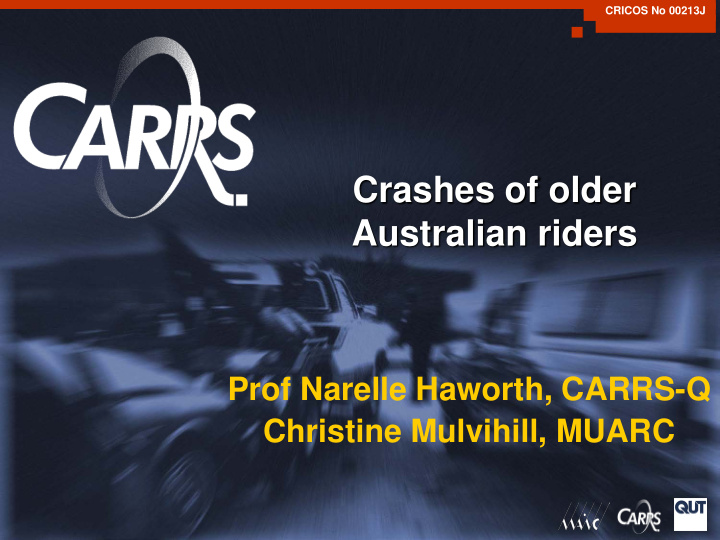



CRICOS No 00213J Crashes of older Australian riders Prof Narelle Haworth, CARRS-Q Christine Mulvihill, MUARC
Outline Motorcycle crash trends and rates Types of older riders Survey method Survey results Conclusions
Motorcyclist fatalities in Australia and US 120 17-25 26-39 100 40+ 80 Fatalities 60 40 20 0 1991 1992 1993 1994 1995 1996 1997 1998 1999 2000 2001 2002 2003 2004 2005 2000 <30 1800 30-39 1600 40+ 1400 1200 1000 800 600 400 200 0 1994 2004
Australian fatality rates per million VKT 1998-2000 (from ATSB, 2002) 50 45 Motorcycle riders 40 Other vehicle operators 35 30 Rate 25 20 15 10 5 0 17-25 26-39 40+
Crashes of new, continuing and returned older riders Newly licensed older riders have more crashes per year than other older riders Do the groups differ in terms of… − crashes per distance travelled? − crash severity? − types of crashes? − contributing factors to crashes? Are returned riders who have completed refresher courses safer?
Responses 2,343 site visitors after pilot phase 1,500 valid questionnaires including 74 paper 19% new riders, 62% continuing, 17% returned
Rider characteristics New riders younger than continuing and returned (means 39, 46, and 49 years) New riders more likely to be female (29% versus 8%) In an average week… Quarter of riders rode 50 kms or less Another quarter rode 51-100 kms Continuing riders rode further Younger riders rode further
Crash involvement Crashes defined as On road within Australia In last 5 years Someone was hurt, Police were called, or vehicle had to be taken away About 30% in at least one crash in the last 5 years 35% continuing riders, 30% new riders, 24% returned riders (but new riders may not have ridden for whole 5 years) Cuts and bruises in 46% of crashes Injuries less severe for new riders Crashed riders aged 55 – 64 more likely to be admitted to hospital
Crash risk Multivariate logistic regression showed that risk of being involved in at least one crash in last 5 years Decreased with age Was higher for males and riders who had completed a training course Was higher for riders who rode more than 201 km/week than those who rode less than 50 km/week Was lower for returned riders than continuing riders
Crash characteristics 53% single vehicle (61% of new rider crashes) 28% at intersections speed zones 53% 60 km/h or less 23% 70-90 km/h 24% 100-110 km/h more single vehicle at higher speed zones
Contributing factors to crashes Unfamiliarity 14% of new riders had ridden the bike less than 1,000 kms (9% returned, 4% continuing) 29% of new riders had not ridden in the crash location before (22% returned, 13% continuing) Road surface factors slippery surfaces (18%) loose gravel (18% - more for new riders)
Main contribution from rider 0 5 10 15 20 25 30 35 40 45 none too fast unpredictable action noticed too late not braking quickly distracted not knowing what to do not being able to handle bike unfamiliar location new continuing returned
Main contribution from other driver to multi-vehicle crashes 0 10 20 30 40 50 60 70 none too fast unpredictable action did not give way noticed too late not braking quickly distracted not knowing what to do unfamiliar location new continuing returned
Rider training and crash involvement Training compulsory some States and not others 93% new riders, 67% continuing riders, 57% returned riders Advanced course was most recent for about half of trained continuing and returned riders Licence course was most recent for about half of trained new riders Trained riders were more likely to have been involved in a crash
Refresher courses for returned riders Less than 10% of returned riders had completed a refresher course, but 30% had completed an advanced course More continuing than returned riders had completed a refresher course
1. Do the groups differ in terms of crashes per distance travelled? Yes, crash risk was significantly lower for returned riders than continuing riders after adjusting for distance travelled. Hard to answer for new riders because many had ridden for less than 5 years.
2. Do the groups differ in terms of crash severity? Yes, injuries less severe for new riders. Crashed riders aged 55-64 more likely to be admitted to hospital. 3. Do the groups differ in terms of type of crash? Yes, new riders have more single vehicle crashes.
4. Do the groups differ in terms of contributing factors to crashes? Yes, new riders reported more difficulties with loose gravel, not knowing how to respond, more often unfamiliar with motorcycle and/or location. In multi-vehicle crashes, new riders thought the other driver noticed them too late or was distracted. Returned riders thought the other driver was driving too fast or did not know what to do.
5. Are returned riders who have completed refresher courses safer? Relatively few returned riders had completed refresher courses. Some indication of lower crash involvement but more analysis required. Don’t know if refresher courses improved their safety or whether safer riders took these courses.
Acknowledgements This research was funded by a grant from the Motor Accidents Authority of New South Wales. Contact details n.haworth@qut.edu.au christine.mulvihill@muarc.monash.edu.au
Recommend
More recommend